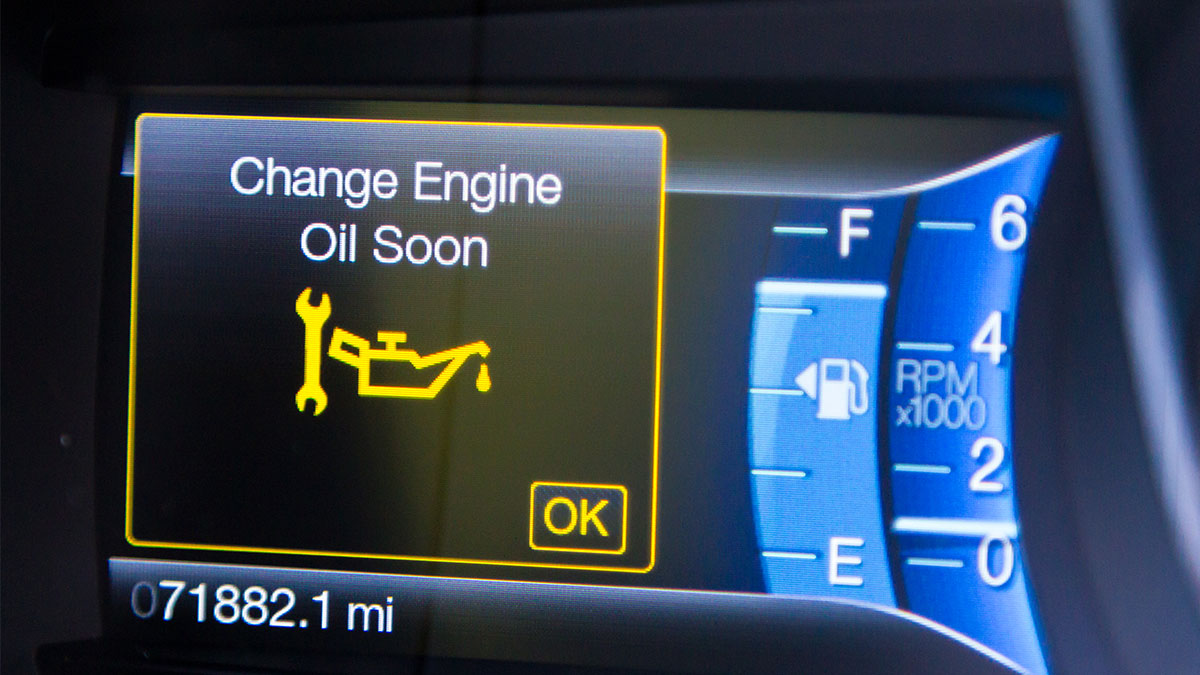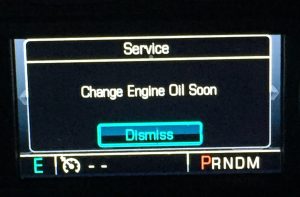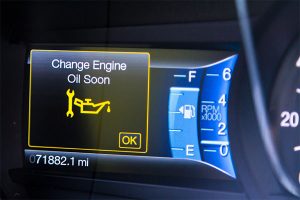Not long ago, most people changed oil every 3,000 miles (4,800 km). No matter what. Well, except AMSOIL users who took advantage of the 25,000-mile (40,200-km)/1-year drain interval of our top-tier synthetic oil. Then oil life monitors (OLM) came along and changed the game.
While first-generation oil life monitors were simple, mileage-based systems that prescribed fixed oil-change intervals regardless of operating conditions, today’s systems are far more sophisticated. They monitor several conditions known to reduce oil life, enter those values into an algorithm and return the oil-life percentage you see on your vehicle’s display.
Today, it’s common for an OLM in a vehicle driven mostly under normal service to recommend an oil change after 10,000 miles (16,000 km) or more. They’ve prevented the waste of countless quarts of perfectly good oil over the years.
What does an oil life monitor track?
Honestly, oil-life monitor is a poor description for these systems. A better name is oil life estimator. They do not monitor any direct physical or chemical property of oil; they only accumulate data from the vehicle’s computer and predict how your driving habits and operating conditions have affected the oil’s viscosity, total base number (a measure of remaining detergency), oxidation level and other factors.
Since the OLM can’t measure these key properties like a chemist in a lab would measure them, how can it know when the oil has, for example, only 10 percent life remaining? It can’t – it simply estimates oil life based on an algorithm.
Driving conditions affect oil life percentage
Oil life monitors track climate, driving habits and other conditions. The algorithm calculates mileage, idle time, engine temperatures, trip times, engine loads, and ignition starts and stops. It then establishes an oil change interval as low as 3,000 miles (4,800 km) and all the way up to 10,000 miles (16,000 km) and more depending on severity of conditions.
Typically, an OLM establishes oil-change intervals in the 5,000-7,000 mile (8,000-11,000 km) range.
Here is a real-world example: Say you start your car 20 minutes before you leave the house because it’s -30˚F (-34ºC) outside and you like to get in a warm car.
Then you drive about 15 minutes to work. These conditions will lead to a shorter oil change interval since increased idle time, cold temperatures and frequent short trips shorten oil life more than “normal” operating conditions.
Find out: Should I Warm Up My Car in Winter?
Oil life monitors are advanced compared to the universal 3,000-mile oil change from years ago. However, there are some gaps in the technology.
Here are a few things oil life monitors don’t track
- Oil Level – Oil life monitors don’t keep track of the amount of oil in your engine. However, if you completely run out of oil, hopefully your oil pressure light will illuminate before your engine fails. It’s good practice to check oil at least every month to help avoid such a scenario.
- Oil Quality – Oil life monitors have no ability to measure oil quality. They can’t distinguish between, for example, AMSOIL Signature Series Synthetic Motor Oil and vegetable oil (do not try that at home). That’s why your oil life monitor may trigger even though the oil in your engine still has thousands of miles to go before requiring a change. In such cases, you can safely use the oil for the full drain interval recommended on the label.
- Oil Condition– Like I said, as sophisticated as your OLM is, it can’t tell you, for example, that there are 1,000 ppm of wear metal in your oil. Only oil analysis can do that. If you have not tried it, I highly recommend it. Oil analysis can give insight into many different aspects of your vehicle.
How to reset your oil life monitor
This is the biggest question surrounding oil life monitors. They’re all a little different.
Some older vehicles require turning the key and pumping the accelerator a few times while the chime is sounding. Newer vehicles often require navigating to the proper screen on the display and following the prompts.
Consult your owner’s manual or YouTube for directions. I have found that searching the year, make, model and “oil monitor reset” yields great instructions.
Why are oil life monitors necessary?
Despite their shortcomings, oil life monitors offer a better alternative to wasting perfectly good motor oil.
Your OLM also acts as a safeguard against driving too long without an oil change in severe service. Many motorists may not realize they subject their vehicles to extended idle times or frequent short trips, which can expose the engine to wear if you don’t keep on top of oil changes.
Updated. Originally published Jan. 22, 2018.








Amzoil wasn’t the answer to my 2007 Suburban with the 5.3 engine. After having oil consumption problems starting at around 160,000 miles it dropped a lifter at 210,000 miles. I went ahead and replaced the engine with a Jasper remanufactured engine which is much cheaper than buying a new comparable Suburban for $80,000+ . The cost of the vehicle was why I use Amzoil products in the first place.
Doubt the issue had anything to do with amsoil. Amsoil is a great oil. But not a cure all. If it’s worn out or going to fail no oil will stop that.
GM 5.3 had issues with oil consumption along with Subaru and others.
They were trying to use low friction piston rings. They didn’t have enough tension to scrape the excess oil from the cylinder wall.
You got great milage out of that first gen 5.3 . That was probably due to using AMSOIL.
Most first gen 5.3 didn’t go anywhere near those miles.
GM had a major issue with the valve train as there cylinder deactivation on the first gen 5.3.was a complete disaster…..
Rob
Good one! Thank you for sharing such an amazing post I found it really very useful and interesting.
Nice article and a handful tip!
Thanks for sharing.
Nice blog. keep sharing with us.
Nice Post. Thanks for sharing the informative post.
GR8 explanation!
This post does not talk about viscosity of the motor oil. Does the monitor detect and/or calculate viscosity? How does the viscosity come into play in the motor oil life? The old or traditional way is to look at the motor oil color: if the color is clear and free of brownish or black debris, the oil is still good.
Now the question is this: if by looking at the motor oil and it looks clear, but the indicator says the life is 20%, should the motor oil be changed?
Thank you.
Hi Derren,
No, oil-life monitors do not measure oil viscosity. They are incapable of chemically analyzing the oil. They are simply algorithms that prescribe when to change oil based on mileage, idle time, duration and other factors.
As we point out in this post, you can’t necessarily trust your eyes to determine when to change oil. The color of the oil doesn’t necessarily indicate when it requires changing.
Thanks,
John
Thanks, this is handy information. Does the algorithm then allow adequately for the “severe” cold temperature conditions in Canada?
My Jeep dealer recommends oil changes every 7,500km (of course) but the oil monitor let’s me go 15,000 km (nearly 10,000 miles) and I am slightly concerned that that is pushing it a bit?
Hi Hendrik,
Yes, oil life monitors can track ambient temperatures and use that information to prescribe oil-change intervals. If you’re concerned about pushing the oil too far, make sure you’re using a high-quality synthetic capable of delivering extended drain intervals. Living in Canada where cold is common, you want to use a good synthetic anyway to ensure the oil flows quickly at start-up for easier starts and better wear protection.
Thanks,
John
Several of our ambulances were switched to Amsoil. Oil consumption increased on the diesel engines. Can you explain why this happens?
Hi Kevin,
We need more information to provide any insight. What specific oil did you use? Were you monitoring oil consumption in the past? What engine? Do you extend drain intervals? Also, some oil consumption is normal and occurs as a result of oil that coats the cylinder wall burning. Some engine manufacturers, for example, consider up to a quart of oil consumption every 1500 miles or so to be “normal.”
To help us understand your situation better, please call AMSOIL Technical Services at 715-399-TECH and we’ll be glad to help.
Thanks,
John
Did you check oil levels when engine was cold ?? I had this issue with emergency vehicles that were running 24/7. Each shift would check oil hot and add. They were actually overfilling them. When I convinced them to wait several shifts to add oil they found out they weren’t using oil. They also noticed they ran cooler. This was for both gas and Diesel engines.
My truck is used mostly for towing.Does the oil life monitor factor this in?
Hi Tommy,
The oil-life monitor measures factors like temperature, idle time, rpm and mileage, but it can’t determine whether or not you’re actually towing. Towing typically increases temperature, so the OLM will detect that temperature increase, however. Check your owner’s manual to see if shorter oil-changes are recommended when towing.
Thanks,
John
Incorrect. Part of the algorithm is ‘engine load’
Throttle position = Engine load. When towing your foot will be in the throttle more than when not towing.
The best source of info and totally informative I really appreciate your thoughts.
what about smart tech in automotive industry what are your ideas about that ?
Thanks, really got to know and understand more about oil monitors.
I think oil monitors are nice because they tailor services to how you drive not some generic schedule. Just be sure to at least use the minimum recommended quality of oil whether that be synthetic, semi synthetic oil. In general manufactures don’t recommend standard oils for extended drains. If you rather get those cheap $20 oil changes I would stick to a shorter interval. I like to stick with full synthetics for many reasons besides to advantage of extended drains. Don’t forget too that a good oil filter is critical for extended drains as well.
OLM functionality is nice as a reminder. As the article states though, they’re by no means a true indicator of the condition of the oil (and filtration).
Me? I run full synthetic with a quality oil filter (brands omitted on purpose). When my OLM indicates that I need an oil change, I take a sample and send it off to an independent lab to have the oil analyzed. When the analysis comes back, I’ll assess whether an oil change is really warranted or whether the oil can be run a bit longer. In essence, I take what the OLM indicates with a grain of salt.
Over time, I’ve found that my OLM tends to indicate an oil change is needed about every 5,000 miles. Through independent oil analysis, I’ve found that the oil (and filter) I’m using easily lasts until 15,000 miles given my vehicle and my driving conditions.
Keep in mind that auto manufacturers also make money servicing your vehicle…
Standard disclaimers apply – your mileage may vary!
A lot of people don’t understand that the reason for 0W20 in some motors is because of the variable valve timing mech. needs this light oil to work properly. The manufacturer should explain this to people more in there operators service manuals, which I am sure a lot of people don’t read.
Where can I get my personal car oil analyzed ??
Hi David,
Oil Analyzers INC. offers used oil analysis for passenger cars and trucks. Get more information here.
Thanks,
John
Thanks for the explanation. It’s all new to me in that my light never came on until now!! So I guess my oil changes have been more than frequent enough so the warning never came on. Skip to now! Had an oil change 3 months ago, have only driven 400 miles, and the change engine oil light came on. Dipstick shows no loss of oil. So the question I have is when the mechanic changes the oil does that automatically set oil life to 100%? Or does the mechanic set it to 100% a manually?
Hi Bruce,
Simply changing the oil won’t automatically reset the oil-life monitor. The mechanic must manually reset it after changing oil. It’s usually a simple process that’s explained in your owner’s manual.
Thanks,
John
Good stuff. Anything that helps to gauge oil change frequency more accurately is very important.
One of the biggest issues of changing the oil too often, is environmental damage. Per some reports:
“153.5 million gallons of used oil is being generated in California every year, but only 59 percent of it is ever recycled.”
And that’s pretty messed up. Considering how many vehicles and other motor machines are out there which all use oil, the environmental impact of oil change frequency can be absolutely astronomical. Every effort should be taken to get the most out of the oil you have, because I don’t think any of us wants to see that stuff dumped in the ground or into any rivers or oceans.
I’ve read and been told on multiple occasions, by different sources, that oil needs to be changed every 6 months, regardless of use. The reason I’ve been given is that once moisture and fuel contaminate the oil, it will become acidic, eventually causing corrosion. No one has ever suggested that it’s going to eat through the oil pan, but it has always been recommend to me to prevent issues, that the rule of thumb should be to always change oil a minimum of every 6 months in vehicles or equipment that doesn’t get much use. Anyone ever heard or can confirm/deny this? We have some fleet vehicles that can be parked for a year or more at a time, and while they don’t get oil changes with zero miles, I wonder if we need to change it at all.
Hi Adam,
It’s true that oil eventually requires changing even if you put zero miles on the vehicle. Over time, oxygen degrades the oil, just like oxygen causes iron to rust or an apple to turn brown. Moisture, too, can collect in the oil due to changes in ambient temperature.
Precisely how long the oil can last, however, depends on the quality of the base oils used in the formulation. High-quality motors oils can last up to a year before requiring a change, such as AMSOIL Signature Series Synthetic Motor Oil and AMSOIL XL Synthetic Motor Oil. Like anything, the better the quality, the longer it’ll last.
This article provides a little more information if you’re interested.
Thanks,
John
Since early 2000’s BMW luxury models and Rolls Royce contain an oil condition sensor. This sensor measures electrical stability thru capacitance, using the motor oil as an insulator which send bit serial data to the engine control module. Thru algorithms, can adjust the oil change life in the car communication computer.
Great post about oil life monitor, perhaps I will try to test that one out to see if it’s that benefit.
I purchased a used 2010 Honda CRV with 130,000 miles that I use for a 50-mile highway commute. The maintenance minder system reached 0% after 15,000 miles. This seems like a lot of miles between oil changes to me and wanted your opinion if I should trust it?
Hi Michael,
While 15,000 miles is a lot, it’s not out of the question if you’re primarily driving on the highway. Did the system recommend changing the oil prior to reaching 0 percent? For example, once it hit 10 percent or 5 percent?
Automakers invest a lot of time and effort in designing their oil life monitor systems to safely extend oil-change intervals. This helps you avoid unnecessary maintenance while reducing waste oil. It’s a win-win.
However, if you’re concerned about engine protection after 15,000 miles on the same oil, upgrade to a good synthetic for the reserve protection and peace of mind. AMSOIL Signature Series Synthetic Motor Oil is guaranteed for up to 25,000 miles or one year, while XL Synthetic Motor Oil is guaranteed for up to 12,000 miles/one year or the recommendation given by your oil life monitor.
Thanks,
John
Good one! Thank you for sharing such an amazing post I found it really very useful and interesting.
I use full synthetic oil on my 2018 Equinox. Paying attention to the OLM (and the oil change sticker), I get really great mileage. Led to the dealership & warranty company using it as leverage to say I wasn’t maintaining my vehicle properly. I’m averaging 3 a year. I think they’re full of it.
I change my oil and filter when I can’t see my oil dip stick level lines through the oil. Fifty years of doing it this way and never ever had a problem
Sorry, but I call BS on that article! I drive thousands of miles in a year and over an hr 1way to work every day. The Oil Life goes off at exactly 5,000mi every single time… even with Royal Purple!
Y’all either sell oil or provide oil changes to tell this blatant of of a lie.
Hi John. Is it possible to find out when or at what mileage my OLM was last reset? I can’t find the receipt from the shop where I had the oil changed last time. I know only they reset OLM. Instead of waiting for the reminder to pop up, I’d like to know how much time or mileage remains, since I’m planning for a long-distance trip. My car is 2018 Toyota. Thank you!
Hi Yong,
Unfortunately, I don’t know if that’s possible. I suggest checking your owner’s manual for instructions. If that doesn’t work, call a Toyota dealership and ask them.
Good luck,
John